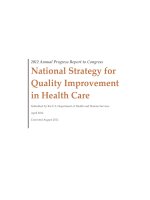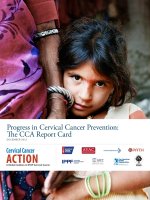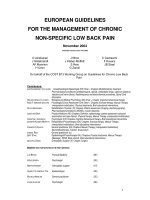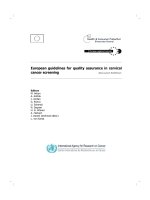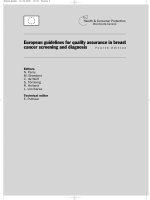European guidelines for quality assurance in cervical cancer screening pptx
Bạn đang xem bản rút gọn của tài liệu. Xem và tải ngay bản đầy đủ của tài liệu tại đây (8.63 MB, 324 trang )
European guidelines for quality assurance in cervical
cancer screening
Second Edition
Editors
M. Arbyn
A. Anttila
J. Jordan
G. Ronco
U. Schenck
N. Segnan
H. G. Wiener
A. Herbert
J. Daniel (technical editor)
L. von Karsa
This document has been prepared with financial support from the European Communities through
the Europe Against Cancer Programme (European Cervical Cancer Screening Network) and the EU
Public Health Programme (European Cancer Network).
The views expressed in this document are those of the authors and do not necessarily reflect the
official position of the European Commission.
Neither the Commission nor any person acting on its behalf can be held responsible for any use
that may be made of the information in this document.
Europe Direct is a service to help you find answers
to your questions about the European Union
Freephone number (*):
00 800 6 7 8 9 10 11
(*) Certain mobile telephone operators do not allow access to 00 800 numbers or these calls
may be billed.
More information on the European Union is available on the Internet ().
Cataloguing data can be found at the end of this publication.
Luxembourg: Office for Official Publications of the European Communities, 2008
ISBN 978-92-79-07698-5
© European Communities, 2008
Printed in Belgium
Printed on white chlorine-free paper
II
European guidelines for quality assurance in cervical cancer screening – Second edition
EDITORS
Marc Arbyn
Unit of Cancer Epidemiology, Department of Epidemiology
Scientific Institute of Public Health
Brussels, Belgium
Ahti Anttila
Mass Screening Registry, Finnish Cancer Registry
Helsinki, Finland
Joe Jordan
Birmingham Women’s Hospital
Birmingham, United Kingdom
Guglielmo Ronco
Unit of Cancer Epidemiology
Centre for Cancer Epidemiology and Prevention (CPO Piemonte)
Turin, Italy
Ulrich Schenck
Institute of Pathology, Technical University
Munich, Germany
Nereo Segnan
Unit of cancer Epidemiology, Department of Oncology
CPO Piemonte (Piedmont Centre for Cancer Prevention) and S. Giovanni Hospital
Turin, Italy
Helene G. Wiener
Clinical Institute of Pathology, Medical University of Vienna
Vienna, Austria
Amanda Herbert
Guy’s & St Thomas’ NHS Foundation Trust
London, United Kingdom
John Daniel
International Agency for Research on Cancer
Lyon, France
Lawrence von Karsa
European Cancer Network (ECN) Coordination Office
Screening Quality Control Group
International Agency for Research on Cancer
Lyon, France
European guidelines for quality assurance in cervical cancer screening – Second edition
III
Address for correspondence
European Cancer Network (ECN) Coordination Office
International Agency for Research on Cancer
150 cours Albert Thomas
F-69372 Lyon cedex 08 / France
IV
European guidelines for quality assurance in cervical cancer screening – Second edition
CONTRIBUTORS
Contributors
Charles Anthony, Center for Public Health and Preventive Medicine
Ormylia, Greece
Ahti Anttila, Mass Screening Registry, Finnish Cancer Registry
Helsinki, Finland
Marc Arbyn, Unit of Cancer Epidemiology, Department of Epidemiology,
Scientific Institute of Public Health
Brussels, Belgium
Joan Austoker, Division of Public Health and Primary Health Care
Oxford, United Kingdom
Jean-Jacques Baldauf, Department of Obstetrics and Gynaecology, Hôpitaux
Universitaires de Strasbourg
Strasbourg, France
Nikolaus Becker, German Cancer Research Centre
Heidelberg, Germany
Christine Bergeron, Laboratoire Pasteur Cerba
Cergy-Pontoise, France
Miklós Bodó, Semmelweis University, I. Pathological Institute
Budapest, Hungary
Peter Boyle
International Agency for Research on Cancer
Lyon, France
Johan Bulten, Institute of Pathology, Radboud University Nijmegen Medical Centre
Nijmegen, The Netherlands
Christine Clavel, Laboratoire Pol Bouin
Reims, France
John Daniel
International Agency for Research on Cancer
Lyon, France
Philip Davies, European Cervical Cancer Association
Lyon, France
European guidelines for quality assurance in cervical cancer screening – Second edition
V
CONTRIBUTORS
Santiago Dexeus, Instituto Dexeus
Barcelona, Spain
Joakim Dillner, Department of Medical Microbiology, Lund University
Lund, Sweden
Lajos Döbr ssy, Office of Chief Medical Officer
Iklad, Hungary
Muriel Fender, Association EVE
Strasbourg, France
Livia Giordano, CPO Piemonte
Turin, Italy
Matti Hakama, School of Public Health, University of Tampere
Tampere, Finland
Amanda Herbert, Guy’s & St Thomas’ NHS Foundation Trust
London, United Kingdom
Reinhard Horvat, Institute of Pathology
Vienna, Austria
Thomas Iftner, Institute of Medical Virology
Tubingen, Germany
Joe Jordan, Birmingham Women’s Hospital
Birmingham, United Kingdom
Lawrence von Karsa, European Cancer Network
International Agency for Research on Cancer
Lyon, France
Paul Klinkhamer, PAMM
Eindhoven, The Netherlands
Markos Kyprianou
European Commissioner for Health and Consumer Protection
Elsebeth Lynge, Institute of Public Health, University of Copenhagen
Copenhagen, Denmark
Pierre Martin-Hirsch, Department of Obstetrics and Gynaecology, Royal Preston
Hospital
Preston, United Kingdom
VI
European guidelines for quality assurance in cervical cancer screening – Second edition
CONTRIBUTORS
Euphemia McGoogan, formerly Department of Pathology, University of Edinburgh
Edinburgh, United Kingdom
Anthony B. Miller, Deutsches Krebsforschungzentrum
Heidelberg, Germany
Guillermo Domenech Muniz, Directorate General of Public Health
Junta de Castilla y León, Spain
Pekka Nieminen, Helsinki University Central Hospital
Helsinki, Finland
Sonia Pagliusi, formerly, Initiative for Vaccine Research, Vaccines and Biologicals, Family
and Community Health, WHO
Geneva, Switzerland
Julietta Patnick, National Health System Cervical Cancer Screening Programme
Sheffield, United Kingdom
Walter Prendiville, Coombe Women’s Hospital
Dublin, Ireland
Odette Real, Centro de Oncologia de Coimbra
Coimbra, Portugal
Guglielmo Ronco, Unit of Cancer Epidemiology, CPO Piemonte
Turin, Italy
Amaya Hernandez Rubio, Directorate General of Public Health
Junta de Castilla y León, Spain
Peter Sasieni, Wolfson Institute of Preventive Medicine
London, United Kingdom
Ulrich Schenck, Institute of Pathology, Technical University
Munich, Germany
Nereo Segnan, Unit of cancer Epidemiology, Department of Oncology, CPO Piemonte
and S. Giovanni Hospital
Turin, Italy
Peter Stern, Paterson Institute for Cancer Research
Manchester, United Kingdom
Daniel Da Silva, Centro de Oncologia de Coimbra
Coimbra, Portugal
European guidelines for quality assurance in cervical cancer screening – Second edition
VII
CONTRIBUTORS
Pär Sparen, Department of Medical Epidemiology and Biostatistics, Karolinska Institute
Stockholm, Sweden
Silvia Tejero Encinas, Regional Health Service – Hospital General Yagüe of Burgos
Junta de Castilla y León, Spain
Anne Szarewski, Imperial Cancer Fund
London, United Kingdom
Premila Webster, Division of Public Health and Primary Health Care
Oxford, United Kingdom
Elisabete Weiderpass, Norwegian Cancer Register
Oslo, Norway
Helene G. Wiener, Clinical Institute of Pathology, Medical University of Vienna
Vienna, Austria
Maja Zakelj, Epidemiology and Cancer Registries, Institute of Oncology
Ljubljana, Slovenia
Conflicts of interest, declared by authors, contributors, editors or reviewers of
chapters of the European Guidelines for Quality Assurance in Cervical Cancer
Screening – Second Edition*
M. Arbyn has received travel grants from producers of HPV vaccines (Smith-Glaxo Kline
and Sanofi Pharmaceuticals, Inc.)
P. Davies has served on the scientific advisory board of Roche Molecular Systems Inc., a
diagnostic test manufacturer, prior to 2007.
J. Dillner is currently a consultant for and a recipient of research grants from a producer of
HPV vaccines (Merck/SPMSD).
T. Iftner is an inventor of patents on a genotyping test ("Primer and probes for detection
of papilloma-viruses", and "detection of human papillomaviruses") whereas the holder of
the patents is either University Hospital Tuebingen or Greiner BioOne.
* Disclosed by experts concerned between August & November 2007. No other potential
conflict of interest relevant to this publication was reported.
VIII
European guidelines for quality assurance in cervical cancer screening – Second edition
Prefaces
PREFACE
Preface
Markos Kyprianou*
Cytological screening every three to five years can prevent up to four out of five cases of
cervical cancer. Such benefits can only be achieved if screening is provided in organized,
population-based programmes with quality assurance at all levels. This is an important
lesson which has been learned through pan-European cooperation and collaboration in the
European Cancer Network.
The completion of the second edition of the European Guidelines for Quality Assurance in
Cervical Cancer Screening is testimony to the unique role the European Union can play in
assuring the efficient delivery of safe and effective services to maintain and improve the
health of Europe’s citizens. Experts from most of the EU member states have collaborated
to prepare the updated recommendations and standards for designing, implementing, and
monitoring the performance of cervical cancer screening programmes including first guidelines for diagnosis and management of screen detected cervical lesions.
Quality assurance of the screening process requires a robust system of programme management and coordination, assuring that all aspects of the service are performing adequately. The first edition of the European Guidelines for Quality Assurance in Cervical Cancer
Screening emphasized the principles of organised, population-based screening and was instrumental in initiating pilot projects in Europe. More than a decade has passed since publication of the first guideline edition.
Subsequently, the Council adopted in December 2003 the Council recommendation on
cancer screening recommending to the Member States, whenever available to follow evidence-based EU guidelines for cancer screening in implementing or improving, e.g., national population-based cervical cancer screening programmes. Therefore the appearance
of this second comprehensive edition of the EU guidelines for Quality Assurance of Cervical
Cancer Screening documents the commitment of the Commission to deliver on the invitation to the Commission by the Council for continued support for the development and
dissemination of high quality EU screening guidelines.
The editors and contributors to the current, expanded guideline edition are to be applauded for providing extensive updates on technical aspects and documentation, as well as
assessment of new technologies. The current recommendations include uniform indicators
for monitoring programme performance and for identifying and reacting to potential
problems at an early time. They are particularly relevant to planning new cervical cancer
screening programmes in Europe.
This Publication of the second edition of the guidelines by the European Union will ensure
that any interested organisation, programme or authority in the Member States as well as
every European Citizen can obtain the recommended standards and procedures and appoint appropriate persons, organisations and institutions for the implementation of those.
Let me finally thank the editors and contributors for their efforts in compiling this volume
which I am confident will be useful to guide work on cervical cancer screening for the
years to come.
Brussels, November 2007
*European Commissioner for Health and Consumer Protection
European guidelines for quality assurance in cervical cancer screening – Second edition
XI
PREFACE
Preface
Peter Boyle*
Screening for cytological abnormalities and treatment of precursor lesions has contributed
significantly to the substantial decline in cervical cancer incidence and mortality rates in
Europe over recent decades. Improvements in the control of cervical cancer have been
particularly discernible in those countries which have implemented population-based
screening programmes with high acceptance of personal invitation. Despite these
successes there is no room for complacency in the ongoing effort for cervical cancer control in Europe. Currently ca. 34,000 new cases and over 16,000 deaths due to cervical cancer are reported annually in the European Union. The burden of cervical cancer is particularly high in the newer EU Member States, and reaches levels approximately 10-fold
greater than the lowest mortality observed elsewhere in the EU. This disparity could be
substantially reduced by implementation of population-based cervical cancer screening
programmes, with effective quality assurance throughout the screening process.
The International Agency for Research on Cancer (IARC) has provided scientific and technical support for development of the second edition of the European Guidelines for Quality
Assurance in Cervical Cancer Screening. Continuously improved quality assurance guidelines based on scientifically sound and applicable screening standards are essential to
assuring that population-based programmes of appropriate quality and effectiveness are
available to all women who may benefit from cervical cancer screening.
European countries which have not yet launched screening programmes, and those which
have already initiated screening are urged to act on the updated and expanded second
edition of the EU Guidelines. Organized, population-based screening programmes should
be implemented where they are lacking, and the updated recommendations and standards
in the EU Guidelines should also be used to improve the quality and effectiveness of
already established screening programmes.
The prevalence of oncogenic human papillomavirus (HPV) types in a number of EU
Member States underlines the priority of increasing efforts to implement and improve
cervical cancer screening programmes. Despite the urgency in dealing with the burden of
cervical cancer in Europe, the guideline editors rightly point out the need for planning prior
to screening programme implementation in order to maximise effectiveness and to permit
evaluation. Furthermore, cancer registration and linkage of screening data with cancer
registry data is essential to monitoring the performance and evaluating the impact of
screening programmes. Widespread application of the standardised performance indicators
recommended in the guidelines will facilitate quality management and will help to recognize programmes and approaches which are more successful. This, in turn, will promote
the international exchange of information and experience between programmes which is
essential for continuous quality improvement.
It should also be noted that the fundamental principles of quality assurance of cervical
cancer screening elucidated in the EU guidelines also apply to settings in which resource
limitations require different test procedures, or a significantly lower number of screening
tests per woman, such as once-in-a-lifetime screening with visual inspection. Publication of
the updated second edition of the EU guidelines is therefore also an important part of the
efforts of the Agency to provide scientific support for regions of the world in which the
burden of cervical cancer is still substantially higher than in Europe.
XII
European guidelines for quality assurance in cervical cancer screening – Second edition
PREFACE
The new second edition of the European guidelines appears at a time in which vaccination
against oncogenic HPV types has the potential to become a valuable tool which can supplement, but not replace, the important role played by screening in effective cervical cancer control. As pointed out by the guideline editors, vaccination of young girls may lead to
substantial reduction in the burden of cervical cancer in future generations of women. For
many years, however, most cervical cancer cases and deaths will occur in women who
have not been vaccinated. Vaccination is not an alternative to screening for the coming
years.
Development of comprehensive European guidelines on cervical cancer prevention which
take both primary and secondary prevention into account is an important aim of IARC activities which will also be pursued in the framework of the recently initiated Guideline updating project coordinated by the Agency and supported by the EU Public Health programme.
Lyon, October 2007
*Director, International Agency for Research on Cancer
European guidelines for quality assurance in cervical cancer screening – Second edition
XIII
TABLE
OF CONTENTS
Table of Contents
Executive Summary
XXIII
Introduction
1
1.1
Burden of cervix cancer in the EU
3
1.2
Cervical cancer and screening
4
1.3
Cause of cervical cancer
4
1.4
European policy: Council Recommendation of 2
December 2003 on Cancer Screening
4
1.5
First edition of the European Guidelines for Quality
Assurance in Cervical Cancer Screening
5
1.6
Content of the second guideline edition
5
1.7
The future
6
1.8
Acknowledgements
7
1.9
References
7
Epidemiological Guidelines for Quality
Assurance in Cervical Cancer Screening
11
2.1
Executive summary
13
2.2
Introduction
14
2.3
Epidemiology of cervical cancer
2.3.1
2.3.1.1
2.3.1.2
2.3.1.3
2.3.2
2.3.3
2.3.4
2.3.4.1
2.3.4.2
2.3.4.3
Burden of disease
Current incidence and mortality of cervical cancer
Trends
Survival
Natural history of disease
Risk factors
Evidence for efficacy and effectiveness of cytological screening
Age group to be targeted
Screening interval
Screening modality: organized vs. opportunistic screening
15
15
15
15
19
20
21
21
22
22
22
2.4
Organization of cervical cancer screening
2.4.1
2.4.1.1
2.4.1.2
2.4.2
2.4.2.1
Principles of the determination of a screening policy
Decision to run a screening programme
European screening policy
Integration within the healthcare system
Defining target population and relevant health-care professionals and
facilities
Inventory of baseline conditions
2.4.2.2
European guidelines for quality assurance in cervical cancer screening – Second edition
25
25
25
25
27
30
32
XV
TABLE
OF CONTENTS
2.4.3
2.4.3.1
2.4.4
2.4.4.1
2.4.4.2
2.4.4.3
2.4.4.4
2.4.5
2.4.5.1
2.4.5.2
2.4.5.3
2.4.5.4
2.4.6
Invitation and attendance
How to reach the target population and increase coverage
Screening test and management of screen-positive women
Smear taking
Smear interpretation and reporting
Management of screen-positive women
Colposcopy and treatment
Health information systems and registration
Registration of the screening programme
Data collection from opportunistic smears
Registration of cervical cancers
Storage of biological materials
Legal and ethical aspects of data collection and linkage
34
34
35
35
36
36
36
37
38
38
39
39
39
2.5
Monitoring and evaluation
2.5.1
2.5.2
2.5.3
2.5.4
Screening outcome
Monitoring
Auditing screening histories of cancer cases
Cost-effectiveness
41
41
44
45
46
2.6
References
47
Annex
Tables
53
Methods for Screening and Diagnosis
69
3.1
Executive summary
71
3.2
Assessment of the performance of screening tests:
principles and criteria
73
3.3
Conventional cervical cytology
77
3.3.1
3.3.1.1
3.3.1.2
3.3.1.3
3.3.1.4
3.3.1.5
3.3.1.6
3.3.2
Description of conventional cervical cytology
Principles of conventional cytology
Reading a cervical smear
Screening technique and localization
Cytological interpretation and reporting
Clinical applications of cervical cytology
Quality of conventional smears
Performance of conventional cervical cytology
77
77
77
77
78
78
78
78
3.4
Liquid-based cytology
3.4.1
3.4.2
3.4.3
3.4.3.1
Description
Rationale for liquid-based cytology
Recent reviews, meta-analyses and pilot studies
Comparison of the test characteristics of liquid-based cytology with the
conventional Pap-smear
Comparison of the adequacy of liquid-based and conventional smears
Pilot projects conducted in Scotland and England
Influencing factors
80
80
81
82
3.4.3.2
3.4.3.3
3.4.3.4
XVI
82
84
84
85
European guidelines for quality assurance in cervical cancer screening – Second edition
TABLE
OF CONTENTS
3.4.3.5
3.4.3.6
3.4.4
3.4.5
Economical aspects of liquid-based cytology
Training and time-trend effects
Recommendations for future research
Conclusions
85
85
86
86
3.5
Quality of the cervical smear
87
3.6
Automated cytological screening
3.6.1
3.6.2
3.6.3
3.6.4
Description of automated screening devices
Rationale for automated screening
Evaluation of performance
Conclusion
88
88
89
89
91
3.7
Colposcopy
3.7.1
3.7.2
3.7.3
Description
Accuracy of colposcopy
Conclusions
91
91
92
93
3.8
HPV DNA detection
93
3.8.1
3.8.2
3.8.2.1
3.8.2.2
3.8.2.3
3.8.2.4
3.8.2.5
3.8.2.6
3.8.2.7
3.8.2.8
3.8.2.9
3.8.2.10
3.8.3
3.8.3.1
3.8.3.2
93
93
93
94
94
95
95
95
95
96
96
97
97
97
3.8.3.4
3.8.3.5
3.8.3.6
3.8.3.7
3.8.4
3.8.5
3.8.6
Introduction
HPV nucleic acid detection systems
Hybrid Capture 2
General primer PCR based on the primer pair GP5+/GP6+
General primer MY09/11 system
SPF10 PCR
Amplicor Human Papillomavirus Test
Real time PCR
HPV DNA typing methods
DNA micro-array chips
Detection of viral oncogene transcripts
Conclusion
Use of HPV testing in primary screening
Cross-sectional accuracy
Age groups to be targeted and screening intervals for HPV screening
programs
Possible strategies to improve the specificity of HPV testing for primary
screening
Follow-up and longitudinal performance
What types of studies are necessary and what should their endpoint be?
Ongoing European randomized trials
Using cost-effectiveness modeling to design HPV screening programs
Use of HPV testing in triaging women with equivocal smears
Use of HPV testing in triaging women with LSIL
Use of HPV testing in follow-up after treatment of CIN
101
102
102
104
104
105
107
109
3.9
Conclusions
111
3.10
References
112
Annex 1
Collection of cellular material of the uterine cervix,
Preparation of an adequate Pap smear
129
Annex 2
Recommendations for cervical cytology terminology
141
3.8.3.3
European guidelines for quality assurance in cervical cancer screening – Second edition
99
XVII
TABLE
OF CONTENTS
Laboratory Guidelines and Quality
Assurance Practices for Cytology
153
4.1
Executive summary
155
4.2
Introduction
155
4.3
Personnel and organization
4.3.1
4.3.2
4.3.2.1
4.3.2.2
4.3.3
4.3.4
4.3.5
4.3.6
General
Requirements for cyto-technologists
Cyto-technologist
Senior cyto-technologist
Requirements for other technical laboratory personnel
Requirements for a cyto-pathologist
Requirements for administrative personnel
Final responsibility
155
155
156
156
156
158
158
158
158
4.4
Material requirements
4.4.1
4.4.2
Buildings, rooms and furniture
Equipment for staining, microscopes, record systems and
teaching materials
159
159
159
160
160
160
160
161
161
161
4.5
Handling and analysis of cervical samples
4.5.1
4.5.2
4.5.2.1
4.5.2.2
4.5.3
4.5.4
Laboratory preparation
Assessment of the sample: stepwise screening
Initial assessment
Samples qualifying for a second screening assessment
Workload requirements – primary screening
Archiving
4.6
Recording of results
4.6.1
4.6.2
4.6.3
Laboratory information system
Authorization of results
Laboratory response time
4.7
Quality management
4.7.1
4.7.1.1
4.7.1.2
4.7.1.3
4.7.2
4.7.2.1
4.7.2.2
4.7.2.3
4.7.3
Internal quality management
Laboratory quality management (preanalytical quality management)
Analytical quality management (cytology)
Internal continuing education
External quality management
External continuing education
External quality control of screening skills
Accreditation of the laboratory unit
Responsibilities for quality control
4.8
Communication
4.8.1
4.8.2
4.8.3
4.8.4
Other laboratories
General practitioners, gynaecologists and other sample-takers
Health authorities
Patients
169
169
169
169
169
4.9
References
170
XVIII
162
162
163
163
163
163
163
164
167
167
167
167
168
169
European guidelines for quality assurance in cervical cancer screening – Second edition
TABLE
OF CONTENTS
Techniques and Quality Assurance
Guidelines for Histopathology
173
5.1
Executive summary
175
5.2
Introduction
175
5.3
Punch biopsies
5.3.1
5.3.2
5.3.3
5.3.4
Diagnostic goal
Macroscopic description
Technique
Histological diagnosis
176
176
176
176
176
5.4
Excision biopsies
5.4.1
5.4.2
5.4.3
5.4.4
Diagnostic goals
Macroscopic description
Technique
Histological diagnosis
5.5
Endo-cervical curettage (ECC)
5.5.1
5.5.2
5.5.3
5.5.4
Diagnostic goal
Macroscopic description
Technique
Histological diagnosis
180
180
181
181
181
5.6
Immunohistochemistry
181
5.7
Data collection
182
5.8
Quality assurance
183
5.9
References
187
Management of Abnormal Cervical Cytology
191
6.1
Executive summary
193
6.2
Introduction
193
6.3
Diagnostic evaluation of the abnormal smear
6.3.1
6.3.2
6.3.3
6.3.3.1
6.3.3.2
6.3.3.3
6.3.3.4
6.3.3.5
6.3.3.6
6.3.3.7
6.3.3.8
6.3.3.9
6.3.3.10
Repeat cytology
HPV testing
Colposcopy
The transformation zone
Technique of colposcopy
Colposcopic features suggestive of CIN
Colposcopic terminology
The new transformation zone classification
Diagnostic accuracy of colposcopy
Colposcopic examination of the vagina and vulva
Colposcopy of the post-menopausal cervix
Colposcopy in pregnancy and in the post partum period
Conclusions for colposcopy
194
194
194
195
195
195
196
197
199
200
200
201
201
201
European guidelines for quality assurance in cervical cancer screening – Second edition
178
178
178
178
179
XIX
TABLE
OF CONTENTS
6.3.4
6.3.5
202
202
6.4
Treatment procedures
6.4.1
6.4.2
Excision of the lesion
Local destructive therapy
203
203
204
6.5
Management of patients according to the severity of
cytological abnormalities
6.5.1
Management of women with atypical squamous cells of
undetermined significance
206
6.5.1.1
6.5.1.2
6.5.1.3
6.5.2
6.5.2.1
6.5.2.2
6.5.3
6.5.3.1
6.5.3.2
6.5.4
Data providing evidence
Management options in case of ASCUS
Management of ASC-H
Management of women with LSIL
Data providing evidence
Management options in case of LSIL
Management of women with HSIL
Data providing evidence
Management options in case of HSIL
Management of women with glandular cytological
abnormality
Data providing evidence
Management options in case of glandular lesions
Management of cervical smears showing endometrial cells
206
206
207
207
207
208
208
208
209
209
6.5.4.1
6.5.4.2
6.5.5
6.6
Management of histologically confirmed CIN
6.6.1
6.6.2
6.6.3
Management of CIN1
Management of CIN2 and CIN3
Micro-invasive cancer
211
211
212
212
6.7
Complications after treatment of CIN
213
6.8
Follow-up after treatment of CIN
6.8.1
6.8.2
6.8.3
Significance of involved margins in the excised specimen
The role of HPV testing in follow-up after treatment
Treatment of residual and recurrent lesions
213
214
214
215
6.9
Management of women in other clinical situations
6.9.1
6.9.2
6.9.3
6.9.4
6.9.5
6.9.6
6.9.7
Management of women with cytological abnormality in
pregnancy
Adolescent women
Post menopausal women
Hysterectomised women
Immuno-suppressed patients
HIV-positive women
Procedure in case of cyto-colposcopical discrepancies
216
216
216
217
217
218
6.10
Quality assurance of patient management
218
6.11
Measures to improve follow-up
6.11.1
6.11.2
Fail-safe measures to assure compliance with follow advice
Correlation of cytology findings with the final histological
diagnosis
219
219
219
6.12
XX
Cervical biopsy
Endo-cervical curettage
Patient information
205
209
210
210
215
215
220
European guidelines for quality assurance in cervical cancer screening – Second edition
TABLE
OF CONTENTS
6.13
Data collection on treatment and follow up of screendetected lesions
220
6.14
References
222
Key Performance Indicators
233
7.1
Executive summary
235
7.2
Screening intensity
235
7.3
Screening test performance
236
7.4
Diagnostic assessment and treatment
237
7.5
Definition of performance parameters in cervical cancer
screening
238
7.5.1
7.5.2
7.5.3
Screening intensity
Screening test performance
Diagnostic assessment and treatment
239
241
243
Annexes
Chapter 2
53
A Tables
Characteristics of the screening
programme
B Tables
Annex
Annual tabulations utilizing individual
screening data
55
57
Chapter 3
Annex 1
Collection of cellular material of the uterine cervix
Preparation of an adequate Pap smear
129
1.1
Introduction
131
1.2
Facilities
131
1.3
Preparing to take the sample
132
1.4
Sampling the transformation zone
1.4.1
1.4.2
1.4.2.1
1.4.2.2
1.4.2.3
1.4.3
1.4.4
Sampling devices
Sampling and preparing a conventional smear
Cervical broom
Combination of spatula and endocervical brush
Sampling with the extended tip spatula alone
Preparing a liquid-based cytology sample
Completing sampling
132
133
134
134
135
136
136
137
1.5
Transport to the laboratory
138
1.6
Feedback on the quality of the specimen
138
European guidelines for quality assurance in cervical cancer screening – Second edition
XXI
TABLE
OF CONTENTS
1.7
Annex 2
References
138
Recommendations for cervical cytology terminology
141
2.1
Introduction
143
2.2
Specimen adequacy
143
2.3
General categorization
143
2.4
Interpretation/result
144
2.4.1
Negative for intraepithelial lesion or
malignancy
Cells indicating a squamous intraepithelial
lesion/neoplasia/ dysplasia
144
144
2.4.2
2.4.2.1
2.4.3
2.4.3.1
2.4.3.2
2.4.3.3
2.4.4
LSIL, mild dysplasia, cellular changes suggesting
CIN1
HSIL, cellular changes suggesting CIN2 / moderate
dysplasia
HSIL, cellular changes suggesting CIN3 / severe
dysplasia / carcinoma in situ
Invasive squamous cell carcinoma
Atypical / borderline squamous cells
Atypical squamous cells – high-grade not excluded
(ASC-H)
Glandular cell abnormalities
Endocervical adenocarcinoma in situ
Adenocarcinoma
Atypical / borderline changes in glandular cells
Other Cellular changes
2.5
Additional remarks
2.5.1
2.5.2
2.5.3
Automated review
Ancillary testing
Educational notes and suggestions
147
147
147
147
2.6
Summary
147
2.7
References
150
2.4.2.2
2.4.2.3
2.4.2.4
2.4.2.5
2.4.2.6
144
145
145
145
145
145
146
146
146
146
147
Appendices
Appendix 1
Appendix 2
Guidance on Communication with women and
health professionals involved in cervical cancer
screening
HPV vaccination – An overview
245
271
Glossary of terms
283
List of abbreviations
289
XXII
European guidelines for quality assurance in cervical cancer screening – Second edition
Executive Summary
Authors:
Marc Arbyn, Brussels, Belgium
Ahti Anttila, Helsinki, Finland
Joe Jordan, Birmingham, United Kingdom
Guglielmo Ronco, Turin, Italy
Ulrich Schenck, Munich, Germany
Nereo Segnan, Turin, Italy
Helene G. Wiener, Vienna, Austria
Amanda Herbert, London, United Kingdom
Lawrence von Karsa, IARC
XXIV
European guidelines for quality assurance in cervical cancer screening – Second edition
EXECUTIVE SUMMARY
Cancer is common in older people but cancer of the uterine cervix primarily affects younger
women, with the majority of cases appearing between the ages of 35 and 50, when many women
are actively involved in their careers or caring for their families. In the European Union (EU) 34 000
new cases and over 16 000 deaths due to cervical cancer are reported annually (Arbyn et al., 2007a
& c).
The burden of cervical cancer is particularly high in the new member states. The highest annual
world-standardised mortality rates are currently reported in Romania and Lithuania (13.7 and
10.0/100 000, respectively) and the lowest rates in Finland (1.1/100 000). Governmental
authorities, parliamentary representatives and advocates should be aware that the substantially
higher dimension of this public health problem in the east of the EU requires special attention.
Among all malignant tumours, cervical cancer is the one that can be most effectively controlled by
screening. Detection of cytological abnormalities by microscopic examination of Pap smears, and
subsequent treatment of women with high-grade cytological abnormalities avoids development of
cancer (Miller, 1993).
Cytological screening at the population level every three to five years can reduce cervical cander
incidence up to 80% (IARC, 2005). Such benefits can only be achieved if quality is optimal at every
step in the screening process, from information and invitation of the eligible target population, to
performance of the screening test and follow-up, and, if necessary, treatment of women with
screen-detected abnormalities.
Quality assurance of the screening process requires a robust system of programme management
and coordination, assuring that all aspects of the service are performing adequately. Attention must
be paid not only to communication and technical aspects but also to qualification of personnel, performance monitoring and audit, as well as evaluation of the impact of screening on the burden of
the disease.
Population-based screening policy and organisation conforming to evidence-based standards and
procedures provide the overall programmatic framework essential to implementation of quality assurance and are therefore crucial to the success of any cervical cancer screening programme.
Establishment of screening registries and linkage of individual screening data with cancer registry
data, taking into account appropriate data protection standards and methods, are essential tools of
monitoring and evaluation.
The first edition of the European Guidelines for Quality Assurance in Cervical Cancer Screening
(Coleman et al., 1993) established the principles of organised, population-based screening and was
pivotal in initiating pilot projects in Europe. A number of countries have in the meantime developed
organised, population-based screening approaches, which are illustrated in the second edition. It is
hoped that this new guideline edition will have a greater impact on those countries in which opportunistic, rather than organised, population-based screening has been the preferred model in the
past. Toward this end, considerable attention has been given to the essential aspects of developing
an organised, population-based programme policy that minimises the adverse effects and maximises the benefits of screening.
The current recommendations are also particularly relevant to planning new cervical cancer screening programmes in Europe. Different solutions fulfilling the recommended methodological standards
need to be implemented in different countries and regions with diverse levels of resources and general healthcare infrastructure.
More than a decade has passed since publication of the first guideline edition. The current,
expanded edition therefore also includes extensive updates on technical details and documentation,
European guidelines for quality assurance in cervical cancer screening – Second edition
XXV

